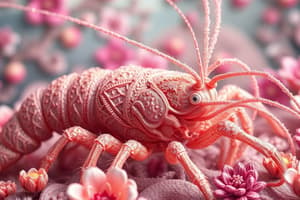Podcast
Questions and Answers
What is the primary source of chitin in nature?
What is the primary source of chitin in nature?
- Mushrooms
- Insects
- Fungi
- Crustaceans (correct)
Which of the following statements accurately describes chitosan?
Which of the following statements accurately describes chitosan?
- It is a deacetylated form of cellulose.
- It is a natural biopolymer abundant in plants.
- It has less structural stability than chitin.
- It is derived from chitin. (correct)
What percentage of dry weight chitin is typically found in the shells of crustaceans?
What percentage of dry weight chitin is typically found in the shells of crustaceans?
- 15% - 30% (correct)
- 1% - 11%
- 30% - 50%
- 10% - 30%
Which allomorph of chitin is the most abundant and has high thermodynamical stability?
Which allomorph of chitin is the most abundant and has high thermodynamical stability?
How many allomorphs of chitin are recognized?
How many allomorphs of chitin are recognized?
In which of the following structures is chitin NOT typically found?
In which of the following structures is chitin NOT typically found?
What is the significance of the structural similarity between chitin and chitosan?
What is the significance of the structural similarity between chitin and chitosan?
From which language is the term 'chitin' derived, and what does it mean?
From which language is the term 'chitin' derived, and what does it mean?
Which characteristic differentiates chitin allomorphs from one another?
Which characteristic differentiates chitin allomorphs from one another?
In which component of organisms is chitin primarily found?
In which component of organisms is chitin primarily found?
Which of the following best describes the environmental significance of chitin?
Which of the following best describes the environmental significance of chitin?
What percentage of chitin is typically found in the dry weight of cockroaches?
What percentage of chitin is typically found in the dry weight of cockroaches?
Which scientist first identified chitin in insects?
Which scientist first identified chitin in insects?
Chitin is primarily composed of which type of macromolecule?
Chitin is primarily composed of which type of macromolecule?
What distinguishes a-chitin from b- and g-chitin?
What distinguishes a-chitin from b- and g-chitin?
What is the primary structural form of chitin found in nature?
What is the primary structural form of chitin found in nature?
What mathematical model is most commonly used to describe the kinetics of hydrogel swelling?
What mathematical model is most commonly used to describe the kinetics of hydrogel swelling?
Which of the following best characterizes the equilibrium swelling percentage of hydrogels?
Which of the following best characterizes the equilibrium swelling percentage of hydrogels?
In the context of hydrogels, what does the swelling ratio assess?
In the context of hydrogels, what does the swelling ratio assess?
Which process can significantly affect the swelling behavior of chitosan-based hydrogels?
Which process can significantly affect the swelling behavior of chitosan-based hydrogels?
How is first order kinetics typically characterized in the context of hydrogel swelling?
How is first order kinetics typically characterized in the context of hydrogel swelling?
Which aspect could hinder the mechanical strength of chitosan hydrogels during applications?
Which aspect could hinder the mechanical strength of chitosan hydrogels during applications?
What role do crosslinking agents like glutaraldehyde play in hydrogel preparation?
What role do crosslinking agents like glutaraldehyde play in hydrogel preparation?
In second order kinetics, how is the swelling process typically characterized?
In second order kinetics, how is the swelling process typically characterized?
What does the symbol 'n' represent in relation to diffusion?
What does the symbol 'n' represent in relation to diffusion?
In Fick's second law of diffusion, what is the role of the variable 'D'?
In Fick's second law of diffusion, what is the role of the variable 'D'?
What is the purpose of plotting data until 60% solvent has entered the gel structure?
What is the purpose of plotting data until 60% solvent has entered the gel structure?
Which temperature range is utilized for the Thermogravimetric Analysis?
Which temperature range is utilized for the Thermogravimetric Analysis?
What is the significance of the intercept value 'k' in diffusion studies?
What is the significance of the intercept value 'k' in diffusion studies?
What does Peleg's empirical equation involve in the context of hydrogel absorption?
What does Peleg's empirical equation involve in the context of hydrogel absorption?
In which type of analysis is the DSC unit Q-200 employed?
In which type of analysis is the DSC unit Q-200 employed?
What is likely the outcome of a nucleophilic attack in crosslinked CS hydrogels?
What is likely the outcome of a nucleophilic attack in crosslinked CS hydrogels?
What does the equation $dS/dt = k_{1r}(S_{eq} - S)$ represent?
What does the equation $dS/dt = k_{1r}(S_{eq} - S)$ represent?
How is the swelling ratio (SR) in hydrogels mathematically defined in the context of second-order kinetics?
How is the swelling ratio (SR) in hydrogels mathematically defined in the context of second-order kinetics?
What indicates that the hydrogel is following first-order kinetics based on the graph of $ln(S_{eq}/(S_{eq} - S))$ versus time (t)?
What indicates that the hydrogel is following first-order kinetics based on the graph of $ln(S_{eq}/(S_{eq} - S))$ versus time (t)?
In the context of hydrogel synthesis, what role does the lone pair of electrons on nitrogen play?
In the context of hydrogel synthesis, what role does the lone pair of electrons on nitrogen play?
What is indicated by the equation $S = 1 + k_{2r}²t$ after integrating from S=0 to S and t=0 to t?
What is indicated by the equation $S = 1 + k_{2r}²t$ after integrating from S=0 to S and t=0 to t?
What characterization is essential for determining the absorption kinetics of a hydrogel?
What characterization is essential for determining the absorption kinetics of a hydrogel?
What does the variable $S_{eq}$ represent in the context of hydrogel swelling?
What does the variable $S_{eq}$ represent in the context of hydrogel swelling?
Which of the following factors impacts the rate constant $k_{1r}$ in first-order kinetic models of hydrogel swelling?
Which of the following factors impacts the rate constant $k_{1r}$ in first-order kinetic models of hydrogel swelling?
Flashcards are hidden until you start studying
Study Notes
Chitin
- Chitin is a natural mucopolysaccharide found in the cell walls of mushrooms and insects.
- It was discovered by Henri Braconnot in 1811 who named it “fungine”, then by Auguste Odier, in 1823, who renamed it to “chitin”.
- Chitin is the second most abundant natural biopolymer in the world, after cellulose.
- It is found in the outer layers of organisms like crustaceans, insects, fungi, and fish.
- Chitin is found in crystalline microfibrils.
- It is the major constituent of the cell wall in fungi and yeast, in teeth of the radula, calcified layers of shells of mollusks, and gladii (pen) of squids.
- Chitin is found in the exoskeleton of arthropods.
- The amount of chitin in crustacean shells is between 15% to 30% of the dry weight.
- It exists in three allomorphs: α, β, and γ.
- These allomorphs differ in their hydration degree, size of the unit cell, number of chains per unit cell, and microfibrils orientation.
- α-chitin is the most common allomorph and has high thermodynamical stability
Chitosan
- Chitosan is a derivative of chitin.
- It is the N-deacetylated form of chitin.
Chitin: Structure and Properties
-
Chitin is a natural mucopolysaccharide found in various organisms including insects, fungi, and crustaceans.
-
Henri Braconnot discovered chitin in 1811, calling it "fungine".
-
Auguste Odier further characterized chitin in 1823.
-
Chitin is the second most abundant natural biopolymer after cellulose.
-
Chitin forms crystalline microfibrils found in various structures:
- Exoskeletons of arthropods
- Cell walls of fungi and yeast
- Teeth of radula (in mollusks)
- Calcified layers of shells (in mollusks)
- Gladii (pens) of squids
-
Chitin content varies by organism:
- Crustacean shells: 15%-30%
- Grasshoppers: 4%-11%
- House crickets: 1%-2%
- Cockroaches: > 38%
- Filamentous fungal cell wall: 10%-30%
- Yeast cell wall: 1%-2%
-
There are three chitin allomorphs: α, β, and γ.
-
Allomorphs are differentiated by:
- Degree of Hydration
- Size of the unit cell
- Number of chains per unit cell
- Orientation of microfibrils
-
α-chitin is the most abundant allomorph and has the highest thermodynamic stability.
Hydrogels & Chitosan (CS)
- Hydrogels are hydrophilic networks, they can be synthetic or natural polymer based.
- Synthetic hydrogels use acrylic acid , acrylamide , polyurethane and poly(ethylene glycol)
- Natural hydrogels use polysaccharides such as cellulose, dextran, starch, and chitosan (CS).
- CS is often used as a base for natural hydrogels
- CS challenges are lack of mechanical strength, swelling time, and biodegradability time
- Blending CS with acrylamide or crosslinking with glutaraldehyde and genipin can increase mechanical strength
- Equilibrium swelling is the maximum absorption capacity of the hydrogel
- The time needed for a hydrogel to reach its equilibrium swelling is a key factor for applications like drug delivery and controlled release
Crosslinked CS Hydrogels
- CS molecular weight: 800,000 Da (1526.464 g/mol)
- Degree of deacetylation 90-98%
- CS is crosslinked with glutaraldehyde
- The crosslinking process involves a nucleophilic attack reaction by the carbonyl carbon of glutaraldehyde due to the lone pair of electrons in the amino group
- Glutaraldehyde concentration influences the rate of swelling and maximum swelling capacity
Swelling of CS Hydrogels
- Swelling ratio (SR) is a measure of hydrogel swelling
- The SR is determined gravimetrically by measuring the weight of a dried pellet before and after immersion in distilled water
- The SR value is correlated to the amount of water absorbed by the hydrogel
Kinetic Models for Swelling
- Three kinetic models for swelling are First Order kinetics, Second Order kinetics, and Fickian Diffusion
- First Order kinetics is characterized by a linear relationship when plotting ln(Seq/(Seq-S)) against t
- Second Order kinetics is characterized by a linear relationship when plotting S against 1/(1+k2rSeqt)
- Fickian diffusion is a common model used to describe swelling
- The diffusion coefficient (D) is calculated using the equation: 𝐷 = 𝑘1/(𝜋𝑟^2(4)).
Applications of Hydrogels
- Hydrogels are widely used in applications like diapers, drug delivery systems, contact lenses, and tissue engineering
- Controlled release fertilizers are an important application of hydrogels, the rate of swelling is critical for effective nutrient release.
- Hydrogels are also used in wound healing, bio-imaging, and biosensors
Studying That Suits You
Use AI to generate personalized quizzes and flashcards to suit your learning preferences.




